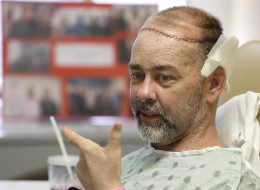
Opening a new frontier in transplant surgery, Texas doctors have done the world’s first partial skull and scalp transplant to help a man who suffered a large head wound from cancer treatment.
Doctors from Houston Methodist Hospital and MD Anderson Cancer Center did the operation two weeks ago.
The recipient – Jim Boysen, a 55-year-old software developer from Austin, Texas – expects to leave the hospital Thursday with a new kidney and pancreas along with the scalp and skull grafts. He said he was stunned at how well doctors matched him to a donor with similar skin and hair coloring.
“It’s kind of shocking, really, how good they got it. I will have way more hair than when I was 21,” Boysen joked in an interview with The Associated Press.

Last year, doctors in the Netherlands said they replaced most of a woman’s skull with a 3-D printed plastic one. The Texas operation is thought to be the first skull-scalp transplant from a human donor, as opposed to an artificial implant or a simple bone graft.
Boysen had a kidney-pancreas transplant in 1992 to treat diabetes he has had since age 5 and has been on drugs to prevent organ rejection. The immune suppression drugs raise the risk of cancer, and he developed a rare type – leiomyosarcoma (lee-oh-my-oh-sar-KOHM-ah).
It can affect many types of smooth muscles but in his case, it was the ones under the scalp that make your hair stand on end when something gives you the creeps.
Radiation therapy for the cancer destroyed part of his head, immune suppression drugs kept his body from repairing the damage, and his transplanted organs were starting to fail – “a perfect storm that made the wound not heal,” Boysen said.
Yet doctors could not perform a new kidney-pancreas transplant as long as he had an open wound. That’s when Dr. Jesse Selber, a reconstructive plastic surgeon at MD Anderson, thought of giving him a new partial skull and scalp at the same time as new organs as a solution to all of his problems.
MORE: TRANSPLANT MILESTONES
- 1954 – first kidney, Brigham & Women’s Hospital in Boston.
- 1966 – first pancreas, University of Minnesota in Minneapolis.
- 1967 – first liver, University of Colorado Health Sciences Center.
- 1967 – first heart, Cape Town, South Africa.
- 1998 – first hand, in Lyons, France.
- 2005 – first face, in Amiens, France.
Houston Methodist, which has transplant expertise, partnered on the venture. It took 18 months for the organ-procurement organization, LifeGift, to find the right donor, who provided all organs for Boysen and was not identified.
Boysen’s wound extended through his skull to his brain, Selber said.
In a 15-hour operation by about a dozen doctors and 40 other health workers, Boysen was given a cap-shaped, 10-by-10-inch skull graft, and a 15-inch-wide scalp graft starting above his forehead, extending across the top of his head and over its crown. It ends an inch above one ear and 2 inches above the other.
Any surgery around the brain is difficult, and this one required delicate work to remove and replace a large part of the skull and re-establish a blood supply to keep the transplant viable.
“We had to connect small blood vessels about one-sixteenth of an inch thick. It’s done under an operating microscope with little stitches about half the thickness of a human hair, using tools like a jeweler would use to make a fine Swiss watch,” said Dr. Michael Klebuc, who led the Houston Methodist plastic surgery team.
The pancreas and kidney were transplanted after the head surgery was done.
“It’s a very ingenious solution” to the patient’s problems, said one independent expert, Dr. Bohdan Pomahac, a reconstructive surgeon at Harvard-affiliated Brigham and Women’s Hospital in Boston. His hospital has done seven face transplants and three double-hand transplants and has plans to do arm and leg ones in the future.
Boysen said he already has sensation in the new scalp.
“That kind of shocked the doctor. He was doing a test yesterday and I said, `Ouch I feel that.’ He kind of jumped back,” Boysen said.
The new scalp also was sweating in the hot room – another surprise so soon after the operation, he said.
“I’m still kind of in awe of it,” Boysen said Thursday at a news conference at Houston Methodist. He will remain in Houston for two to three weeks for follow-up. He will need to keep his head covered because sunlight increases the chance of rejection, his doctors said.
“I’m glad the donor family had the generosity and insight to approve us doing this … to get through their grief and approve the donation of this tissue besides the organs,” said Dr. A. Osama Gaber, transplant chief at Houston Methodist.
Over the last decade, transplants once considered impossible have become a reality. More than two dozen face transplants have been done since the first one in France in 2005; the first one in the U.S. was done in Cleveland in 2008.
More than 70 hand transplants have been done around the world.
Last October, a Swedish woman became the first in the world to give birth after a womb transplant.
A host of patients have received transplants or implants of 3-D printed body parts, ranging from blood vessels to windpipes.
